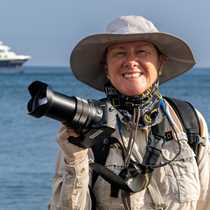San Cristobal Island, Punta Pitt
We pulled into our anchorage around 0700, and dropped anchor off the northeastern-most point of the island. Huge remnants of tuff cones soared above, frigates were up in the air already…
Our exploration of Punta Pitt started immediately after breakfast with a wet landing on a sparkly beach – sparkles because of the tiny olivine crystals mixed with golden tuff that flashed in the early sunlight. The hike is not easy: it required a bit of boulder-hopping up a stream bed (and with the rains this year it is getting washed and eroded daily), then a turn off to the left and a clamber up a steep route. This follows a fissure which is also used by falling water at times, but finally we reached the plateau above. One of Galápagos’ iconic panoramas was spread out in front of us: beige-brown and green slopes steeply dropped off to the golden, shiny beach below; blue water gently (this time of year) touched the shores of San Cristobal to the southwest where black lava made it to the coast, adding yet another tone to our image.
Those who chose not to tackle the climb up Punta Pitt to see the view had instead the delight of a Zodiac cruise along the coast where red-footed boobies, Nazca boobies, great frigatebirds, Galápagos shearwaters, Galápagos storm petrels, red-billed tropicbirds and wandering tattlers all made their home. This one tiny island in particular had over nine species recorded on it!
Of course all this was followed by my own personally favorite sport of snorkeling. Off the beach was one refreshing alternative (especially after the walk), or a deep-water alternative off the small island where sea lions galore entertained everyone with underwater ballet moves and kamikaze frontal bluffs (just to hear us squeal), in between surfing the breakers coming in around the corner upwind.
The afternoon had the ship changing her anchorage to get closer to Leon Dormido, a parasitic tuff cone of steep sides and dramatic fissures that stands alone in the sea. Surrounded by deep water, we had our last deep-water outing and many adventurous takers. Marine turtles were vague shapes in the green, a couple of shark sightings had people alert, and twice rays of undetermined species were seen.
As the sun started to lower and all our people were accounted for on board, the National Geographic Endeavour weighed anchor and started to cruise toward the renowned rock, one of the first sights seen by the crew members of the H.M.S. Beagle in 1835. Leon Dormido, for its form of crouching lion, or Kicker Rock in English – for a hiking boot or high-top sneaker? With the last warm rays of the sun striking the golden cliffs, most of us enjoyed a drink out on the bow as we slowly circled; frigatebirds still soaring, boobies squawking, bow waves gently hitting the hull.
Tonight we heard from many folks in the lounge about their most special moments of the week. Meanwhile on the screens around the lounge, we watched some extraordinary photographs taken by guests and staff over the week, available to all, to be copied, watched, shared with friends and loved ones, memories stirred and reignited into the future.




